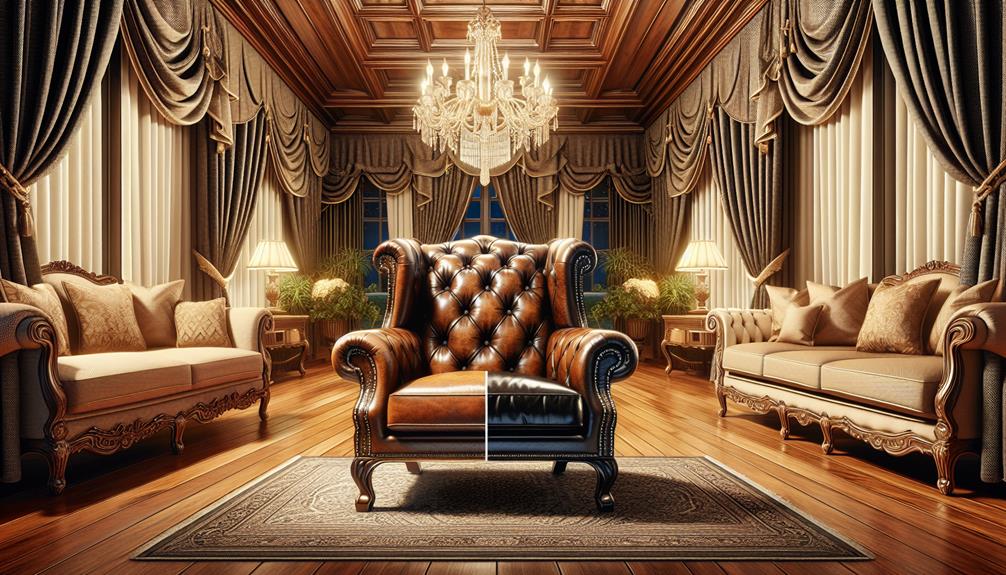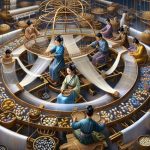Yeah, leather's definitely seen as a luxury! It's been a symbol of the high life for ages, dating back to when ancient civilizations used it to show off their status. There's something about that rich, earthy scent and the way it feels that just screams luxury. Plus, the way it's made—those artisanal methods, the hand-stitching, and the custom details—all of this adds up to make it pretty exclusive. And let's not forget, top fashion brands still grab it up because it makes any outfit look super classy. Stick around, and I'll show you even more about why leather is such a big deal in luxury circles.
Table of Contents
Key Takeaways
- Leather has been a symbol of luxury and status in various cultures for centuries.
- High-end fashion brands use leather for its plush feel and durability, signaling quality.
- Leather goods often involve meticulous, artisanal craftsmanship, enhancing their exclusivity and luxury appeal.
- The rich, earthy scent and unique patina development over time contribute to leather's perception as a luxury material.
- Leather's historical significance and role in clothing emperors and adorning halls underscore its luxurious reputation.
The Historical Significance of Leather
Leather's been a symbol of luxury for centuries, with its roots deeply embedded in ancient civilizations like the Greeks and throughout the Middle Ages. It wasn't just about making something to wear; it was about crafting a status symbol. You see, back then, if you sported leather, you were someone. This tradition of luxury leather goods isn't just old; it's ancient!
The historical significance of leather is massive. It's been a top pick for the elite not just because it lasts, but because it stands out. Imagine walking into a room and the rich, earthy scent of fine leather hits you. That's luxury. That's history walking into the room with you.
Regions with a deep history in crafting leather – think ancient Greece or medieval Europe – they knew what they were onto. They didn't just use leather; they mastered it. And this mastery? It's what set the stage for leather becoming synonymous with luxury today. So, when we talk about luxury leather goods, we're not just talking about a material. We're talking about a rich, storied tradition that has clothed emperors, armored warriors, and adorned the halls of the mighty.
Production and Craftsmanship
Let's talk about how leather products are made.
It's not just about selecting the highest quality materials; the artisanal techniques used are just as critical.
These traditional skills, which require a ton of attention to detail, really help in crafting that luxury feel in leather goods.
Artisanal Techniques Explored
Exploring artisanal techniques, craftsmen handcraft leather using age-old methods that emphasize intricate designs and exceptional quality. Leather craftsmanship isn't just about making a product; it's an art form. Each stitch is sewn with precision, reflecting the dedication and skill that only comes from years of practice.
| Technique | Impact on Product |
|---|---|
| Hand-stitching | Enhances durability, adds a personal touch |
| Hand-tooling | Creates unique, intricate patterns |
| Custom detailing | Ensures exclusivity, aligns with luxury brands |
These artisanal techniques elevate the leather to a high-quality status that's sought after by luxury brands. It's more than just a piece of leather; it's a story of tradition and meticulous care woven into every inch.
Quality Material Selection
Selecting the right materials is crucial in the production of luxury leather goods, as it determines both the aesthetic and longevity of the products. I've learned that using high-quality leather, especially full-grain, is non-negotiable. This top-tier leather not only ages gracefully but also withstands the test of time, showcasing its natural beauty and durability.
The brands I admire don't skimp on this. They're all about premium materials and meticulous attention to detail. It's not just about the look; it's the feel and the durability. Techniques like hand-stitching and vegetable tanning reflect a commitment to sustainability and craftsmanship. This combo sets luxury leather goods apart, making them true symbols of elegance and sophistication.
Leather in High-End Fashion
Leather really sets the bar high in the luxury fashion scene, known for its plush feel and long-lasting quality. When you think about luxury leather goods, what pops into your mind? For me, it's those stunning handbags from Louis Vuitton or sleek Gucci belts. High-end brands have long embraced leather not just for its appeal but for the unmistakable quality it brings to their products.
It's no surprise that walking into any high-end fashion store, you're immediately hit with an array of leather products. From shoes to wallets, these items scream luxury. The craftsmanship involved in creating each piece is top-notch. These aren't just items; they're masterpieces showcasing the designer's commitment to excellence.
For those who know their fashion, the choice of leather speaks volumes. It's about the texture, the finish, and how it complements an ensemble. Leather's got a way of making any outfit look more polished and put together. That's why it's a staple for anyone aiming for a sophisticated look. Whether it's a big conference or a night out, a leather accessory is often the go-to choice. It's not just about looking good, but feeling good knowing you're wearing a piece crafted with perfection.
Durability and Longevity
While we've noted the aesthetic appeal of leather in fashion, let's not overlook its remarkable durability and longevity. When you invest in a leather piece, you're not just buying something stylish; you're getting a product that can last up to five times longer than its synthetic counterparts. That's a big deal if you ask me!
The thing about leather is it actually gets better with time. It develops this unique patina that's not just beautiful but also adds character. And isn't that what true luxury is about? Unique characteristics that stand out and stand the test of time? Here's a quick rundown on why leather is your go-to for durability and longevity:
| Feature | Benefit |
|---|---|
| High-quality material | Lasts up to 5x longer than synthetic materials |
| Develops unique patina | Adds charm and value over time |
| Timeless nature | Remains stylish across decades |
Proper care plays a huge role too. With the right maintenance, these pieces age so gracefully, keeping their allure and functionality intact. So, yeah, leather isn't just durable; it's a smart, long-term investment that keeps paying off.
Ethical and Environmental Concerns
I've gotta say, the more I learn about leather, the more I'm concerned about the ethical and environmental impacts it brings. From the serious animal welfare issues to the pollution and waste it generates during production, it's a lot to think about.
And now, I'm curious about how sustainable alternatives like vegan leather stack up in comparison.
Animal Welfare Issues
One can't ignore the ethical and environmental issues that come with the production of leather, given the immense impact it has on animal welfare and our planet. Over a billion animals are killed each year just for their skins, which really puts the spotlight on the need for higher animal welfare standards and more ethical practices within the industry.
It's troubling to hear about the false claims of welfare standards and the outright cruelty happening in some slaughterhouses. This not only affects the animals but also our environment, contributing to deforestation and other issues.
I think it's high time we consider how our choices, like opting for vegan alternatives, can help reduce this cruelty and environmental impact.
Pollution and Waste
Beyond the ethical issues, the environmental impact of leather production, particularly regarding pollution and waste, is also significant. Let me break down a few key points here:
- Toxic Chemicals: The tanning processes in the leather industry heavily use chemicals like chromium. Not only is this stuff toxic, but it ends up in our waterways, which is a major environmental pollution problem.
- Water Wastage: An incredible amount of water is needed to process leather, which puts a lot of strain on our already limited water resources.
- Waste Production: Leather scraps and offcuts contribute significantly to landfill issues. We're talking big piles of waste that aren't exactly easy to dispose of.
- Ecosystem Impact: When toxic substances from tanneries get into rivers and lakes, the local wildlife and ecosystems take a hit. Not cool at all.
Sustainable Alternatives
As we tackle the ethical and environmental concerns of traditional leather, it's worth exploring the rising stars of sustainable alternatives like cork, Piñatex, and recycled plastics. These materials aren't just eco-friendly; they're a testament to how fashion can evolve.
Vegan leather, for instance, sidesteps the hefty environmental toll of animal leather production, offering a cruelty-free choice that's just as stylish.
Brands like Stella McCartney and Matt & Nat are leading the charge, crafting products that prioritize ethical sourcing and sustainability. They're not alone, as more consumers demand transparency and accountability. This shift is reshaping the industry, proving that luxury doesn't have to compromise our planet's health or our ethical standards.
Alternatives to Traditional Leather
Exploring alternatives to traditional leather, we find options like vegan leather, cork, and pineapple leather that offer sustainable and cruelty-free choices. Diving deeper, let's chat about some really cool materials reshaping the way we think about ethical fashion:
- Vegan Leather: Made from synthetic materials, this one's a hit for those who want the leather look without the guilt. It's versatile and increasingly popular in fashion circles.
- Mushroom Leather: This stuff is made from mycelium, the root structure of fungi. Not only is it biodegradable, but it also has a uniquely earthy texture that's gaining traction.
- Biofabricated Leather: Talk about sci-fi turned reality! This leather is grown from living organisms like yeast. It's a groundbreaking method that's as sustainable as it gets.
- Plant-Based Leather: Think apples, grapes, and cacti turned into leather. These materials provide a cruelty-free alternative that still keeps that chic leather aesthetic.
These innovative materials aren't just good for the planet; they're reshaping what luxury can look like in our closets. They're proof that style and sustainability can go hand in hand.
Identifying Luxury Leather
Identifying luxury leather isn't just about the brand; it's about spotting top-notch quality and craftsmanship. When you're eyeing a piece that claims luxury, full-grain leather should be at the top of your checklist. It's the crème de la crème of leather with its unbeatable durability and the unique way it ages, gaining a gorgeous patina that screams high class.
The production process is another tell. Luxury leather takes its sweet time—tanned, dyed, and finished with an attention to detail that's nothing short of meticulous. This isn't your run-of-the-mill, hurry-up-we-need-to-make-ten-thousand-more kind of process. It's slow, it's careful, and man, does it show in the final product!
And don't forget, types of leather vary. You've got your nubuck, suede, and the shiny allure of patent leather. Each has its own vibe and caters to different luxury tastes.
Here's a quick cheat sheet to keep you savvy:
| Type | Characteristics |
|---|---|
| Full-Grain | Durable, ages well, natural grain |
| Nubuck | Soft, velvety surface, sensitive to moisture |
| Suede | Soft, textured, less durable than full-grain |
| Patent Leather | Glossy finish, water-resistant |
| Production Process | Detailed, slow, enhances luxurious appeal |
Keep these pointers in mind, and you'll spot luxury leather in no time!
Leather's Role in Modern Luxury
Leather's luxurious appeal is undeniable, from high-end fashion to custom furniture, marking it as a symbol of both tradition and high status. When I think about what makes leather so special in the luxury world, a few key points always come to mind:
- Durability and Patina: Leather goods aren't just purchases; they're investments. High-quality leather ages like fine wine, developing a patina that tells a story of elegance and class.
- Exclusivity in Craftsmanship: Luxury brands like Hermès are all about exclusivity. The meticulous craftsmanship that goes into making leather items is just out of this world. It's not just about having something; it's about having something exceptional.
- Symbol of Status: Carrying or wearing leather often sends a message of wealth and high status. It's a subtle way to show the world you appreciate the finer things in life.
- Historical Richness: Leather has been a top choice for the elite for centuries. Its role in fashion and luxury has only grown, highlighting its timeless appeal.
In modern luxury, leather stands out as a testament to quality and style. Whether it's a designer handbag or a bespoke leather sofa, these pieces scream sophistication and durability, making them perennial favorites among those who value lasting luxury.
Frequently Asked Questions
Is Leather a Luxury Goods?
I'd say leather's definitely seen as a luxury good. It's all about the quality, craftsmanship, and that classy look that ages well. Plus, it's pricey, which kinda adds to its luxe vibe.
Is Real Leather Expensive?
Yes, real leather is pricey because it's high quality, durable, and involves detailed craftsmanship. It's a natural material that lasts a long time and gets better with age, justifying its cost.
What Is the Meaning of Luxury Leather?
Luxury leather means top-notch materials and craftsmanship. It's about durability, a fine feel, and aging gracefully. Think Hermès and their high-end goods—totally about status and lasting elegance. It's definitely a style statement.
Why Is Leather Premium?
Leather's premium due to its toughness, long life, and the complex steps in making it. It ages well, gaining character, which really ups its value, especially in high-end brands.
- Fabric Crafts for Kids: Fun Projects - July 24, 2024
- Upcycling Old Clothes: Fashion Tips - July 24, 2024
- Creating Custom Fabric Prints at Home - July 24, 2024








